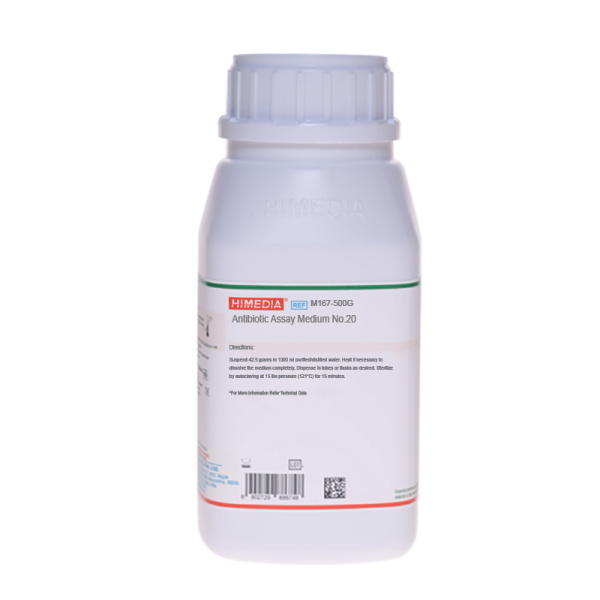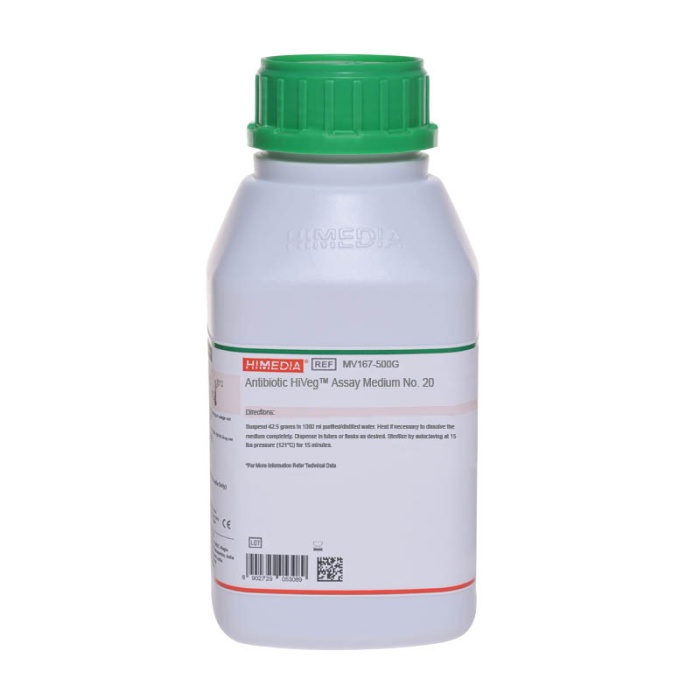 Your enquiry has been submitted
Your enquiry has been submitted
Antibiotic Assay Medium No. 20 (Yeast MB Broth)
Intended Use
Recommended for microbiological assay of Amphotericin B using Candida tropicalis.
Composition**
| Ingredients | Gms / Litre |
|---|---|
| Tryptone | 10.000 |
| Peptone | 5.000 |
| Yeast extract | 6.500 |
| HM peptone B # | 1.500 |
| Dextrose (Glucose) | 11.000 |
| Sodium chloride | 3.500 |
| Dipotassium hydrogen phosphate | 3.680 |
| Potassium dihydrogen phosphate | 1.320 |
| Final pH ( at 25°C) | 6.6±0.2 |
**Formula adjusted, standardized to suit performance parameters
# Equivalent to Beef extract
Directions
Suspend 42.5 grams in 1000 ml purified / distilled water. Heat if necessary to dissolve the medium completely. Dispense in tubes or flasks as desired. Sterilize by autoclaving at 15 lbs pressure (121°C) for 15 minutes.
Principle And Interpretation
Antibiotic Assay media are used in the performance of antibiotic assays. Grove and Randall have elucidated those antibiotic assays and media in their comprehensive treatise on antibiotic assays (1). Schmidt and Moyer have reported the use of antibiotic assay medium for the liquid formulation used in the performance of antibiotic assay (5). These media are prepared according by the FDA (4).
Antibiotic Assay Medium No. 20 is used for turbidometric assay of Amphotericin B using Candida tropicalis ATCC 13803 as test organism. This medium is also known as Yeast beef broth. This medium is also used in assaying mycostatic activity in pharmaceutical related preparations.
High nutritional content like Peptone, yeast extract, HM peptone B and Tryptone provides excellent medium for growth of Candida tropicalis. Dextrose provides carbon and energy for growth of the organism. Osmotic equilibrium to maintain cell intergrity and viability is provided by sodium chloride, while phosphate functions to provide proper buffering action.
Turbidimetric antibiotic assay is based on the change or inhibition of growth of a test microorganims in a liquid medium containing a uniform concentration of an antibiotic. After incubation of the test orgainism in the working dilutions of the antibiotics, the amount of growth is determined by measuring the light transmittance using spectophotometer. The concentration of antibiotic is determined by comparing amounts of growth obtained with that given by the reference standard solutions. Use of this method is appropriate only when test samples are clear.
Type of specimen
Pharmaceutical samples
Specimen Collection and Handling
For pharmaceutical samples, follow appropriate techniques for sample collection, processing as per guidelines (1,4).
After use, contaminated materials must be sterilized by autoclaving before discarding.
Warning and Precautions
Read the label before opening the container. Wear protective gloves/protective clothing/eye protection/ face protection. Follow good microbiological lab practices while handling specimens and culture. Standard precautions as per established guidelines should be followed while handling specimens. Safety guidelines may be referred in individual safety data sheets.
Limitations
- Freshly prepared medium plates must be used or it may result in erroneous results.
Performance and Evaluation
Performance of the medium is expected when used as per the direction on the label within the expiry period when stored at recommended temperature.
Quality Control
Appearance: Cream to yellow homogeneous free flowing powder
Colour and Clarity of prepared medium: Medium amber coloured clear solutiion
Reaction: Reaction of 4.25% w/v aqueous solution at 25°C. pH : 6.6±0.2
pH: 6.40-6.80
Cultural Response
Cultural characteristics observed after an incubation at 35-37°C for 18-48 hours.
| Organism | Growth | Serial dilution with |
|---|---|---|
| Candida tropicalis ATCC 13803 | luxuriant | Amphotericin B |
Storage and Shelf Life
Store between 10-30°C in a tightly closed container and use freshly prepared medium. Use before expiry date on the label. On opening, product should be properly stored dry, after tightly capping the bottle in order to prevent lump formation due to the hygroscopic nature of the product. Improper storage of the product may lead to lump formation. Store in dry ventilated area protected from extremes of temperature and sources of ignition Seal the container tightly after use. Product performance is best if used within stated expiry period.
Disposal
User must ensure safe disposal by autoclaving and/or incineration of used or unusable preparations of this product. Follow established laboratory procedures in disposing of infectious materials and material that comes into contact with sample must be decontaminated and disposed of in accordance with current laboratory techniques (2,3).
Reference
- Grove and Randall, 1955, Assay Methods of Antibiotics Medical Encyclopedia, Inc, New York.
- Isenberg, H.D. Clinical Microbiology Procedures Handbook 2nd Edition.
- Jorgensen, J.H., Pfaller , M.A., Carroll, K.C., Funke, G., Landry, M.L., Richter, S.S and Warnock., D.W. (2015) Manual of Clinical Microbiology, 11th Edition. Vol. 1.
- Tests and Methods of Assay of Antibiotics and Antibiotic containing Drugs, FDA, CFR, 1983. Title 21, part 436, Subpart D, Washington, D.C. U.S Government printing office, paragraphs 436, 100-436, 106 pg 242-259 (April 1).
- Schmidt and Moyer, 1944; J. Bact, 47:199.
| Product Name | Antibiotic Assay Medium No. 20 (Yeast MB Broth) |
|---|---|
| SKU | M167 |
| Product Type | Regular |
| Physical Form | Powder |
| Origin | Animal |
| Packaging type | HDPE |
| References | 1. Grove and Randall, 1955, Assay Methods of Antibiotics Medical Encyclopedia, Inc, New York. 2.Schmidt and Moyer, 1944; J. Bact, 47:199. 3.United States Pharmacopoeia/ National Formulary (USP 28/NF 23), 200 5.US Pharmacopeial Convention Inc, Rockville,Md. 4.Tests and Methods of Assay of Antibiotics and Antibiotic containing Drugs, FDA, CFR, 198 3.Title 21, part 436, SubpartD, Washington, D.C. U.S Government printing office, paragraphs 436, 100-436, 106 pg 242-259 (April 1). |
| Customized Product Available | No |





